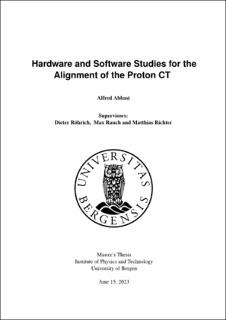Hardware and Software Studies for the Alignment of the Proton CT
Master thesis
Permanent lenke
https://hdl.handle.net/11250/3076410Utgivelsesdato
2023-06-15Metadata
Vis full innførselSamlinger
- Master theses [85]
Sammendrag
Proton therapy is a form of particle therapy using protons to irradiate tumors as a form of cancer treatment. It is becoming more and more popular around the world, including in Norway. To locate the tumor, conventional CT scan is used today, which uses x-ray beams. The proton energy deposition is then achieved by conversions that are not optimal. Proton computed tomography has several important advantages over the conventional computed tomography. The two main advantages are giving a lower dose to the patient during imaging compared to the conventional method and eliminating the need for conversion of photon attenuation to stopping power for protons, which is a source of error. This is necessary in particle therapy, because the physical properties of photons and protons are very different. Using the same type of particles for both imaging and therapy will potentially increase the accuracy of particle therapy treatment plans. For proton CT to be possible, the detectors need to accurately detect the proton tracks and energy depositions and for that the layers of the proton detectors have to be aligned. This master's thesis is an attempt at finding a method for the purpose of alignment in a proton CT detector.
